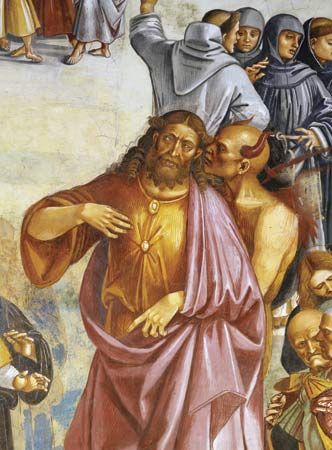Antichrist
Antichrist, the polar opposite and ultimate enemy of Christ. According to Christian tradition, he will reign terribly in the period prior to the Last Judgment. The term Antichrist first appeared in the Letters of John (1 John 2:18, 2:22, and 4:3; 2 John 1:7), and the fully developed story of Antichrist’s life and reign is found in medieval texts. As applied to various individuals and institutions for nearly two millennia, Antichrist and precursor of Antichrist have been, and remain, terms of the most intense opprobrium.
The Christian conception of Antichrist was derived from Jewish traditions, particularly The Book of Daniel in the Hebrew Bible. Written about 167 bce, it foretold the coming of a final persecutor who would “speak great words against the most High and wear out the saints of the most High, and think to change times and laws” (7:25). Scholars agree that the author of Daniel was alluding to the contemporary Hellenistic ruler of Palestine, Antiochus IV Epiphanes, who attempted to extirpate Judaism. But because Antiochus was not named, later readers could apply the prediction in Daniel to any persecutor. Early Christians applied it to the Roman emperors who persecuted the church, in particular Nero (reigned 54–68 ce).
The four books of the New Testament that fueled Christian belief in Antichrist were the first two epistles of John, the Revelation to John, and the Second Letter of Paul to the Thessalonians. The first three of these were written near the end of the 1st century ce; the last was written either by St. Paul the Apostle shortly after 50 ce or by one of Paul’s immediate disciples some 20 or 30 years later. Neither 2 Thessalonians nor Revelation uses the term Antichrist, but both works refer to a coming persecutor who is evidently the same person. The first epistle of John introduces an important distinction between “the” Antichrist who will come and the many antichrists who are already active in the world. This distinction not only enabled believers to denigrate contemporaries as “antichrists” without having to label a single individual as “the” Antichrist but also allowed them to identify the “body of Antichrist” as a collectivity existing in the present but destined to have its day of triumph in the future.

Nevertheless, early Christians tended to emphasize the coming of the one great Antichrist. The Revelation to John refers to this figure as “the Beast from the Abyss” (11:7) and “the Beast from the Sea” (13:1). Many interpret the number of the beast in Revelation 13:18—given as 666, or in some readings 616—to be a gematria reference to emperor Nero. In the most sustained account of the Antichrist’s appearance, 2 Thessalonians 2:1–12, he is called “the man of sin” and “son of perdition.” He will come at a time of a general apostasy, deceive people with signs and wonders, sit in the temple of God, and claim to be God himself. Finally, he will be defeated by Jesus, who will destroy him by “the spirit of his mouth” and “the brightness of his coming” (2:8).
Because even 2 Thessalonians is sketchy about the details of Antichrist’s person and the nature of his reign, a succession of biblical commentators and pseudonymous apocalyptic writers from the era of the Church Fathers and the early Middle Ages began to provide the missing features. Their work was integrated into a brief treatise in the 10th century (c. 954) by a monk from Lorraine, Adso of Montier-en-Der, in a letter to Queen Gerberga of France. Adso’s letter became the standard medieval reference work on Antichrist. In the 13th century it was partially supplanted by several chapters on Antichrist in Hugh Ripelin’s extremely popular handbook, Compendium theologicae veritatis (c. 1265; “Compendium of Theological Truth”). Although it was more orderly, Ripelin’s account differed from Adso’s only in minor details.
The medieval view of Antichrist communicated by Adso, Ripelin, and a host of other writers rested on the principle that Antichrist is the parodic opposite of Christ in all things. (Antichrist literally means “opposed to Christ.”) Thus, as Christ was born of a virgin by means of conception by the Holy Spirit, so Antichrist will be born of a whore by means of conception by a diabolical spirit. Although opinions differed as to whether Antichrist’s father will be a man or a demon, in either case Antichrist will be, as commonly noted in the Middle Ages, “full of the devil” from the time of his conception. Both Christ and Antichrist are born of the Jews, but Antichrist will be born of the tribe of Dan—“the viper in the road” (Genesis 49:17)—rather than the tribe of Judah, and in Babylon, not Bethlehem. Like Christ, Antichrist will grow up in obscurity and begin his open “ministry” at age 30, gaining followers by giving signs and performing miracles. The signs and miracles once more are polar opposites of Christ’s, because Antichrist’s supposed miracles will be only tricks.
Antichrist’s triumphant reign (never clearly distinguished from the start of his ministry) will last for three and a half years. Like Christ, Antichrist will come to Jerusalem, but, as the opposite of Christ, he will be enthusiastically hailed and revered by the Jews. During his reign he will rebuild the Temple and sit on the throne of Solomon in a sacrilegious and hideous inversion of just priesthood and just kingship. He will convert the rulers of the earth to his cause and persecute Christians dreadfully. All those who resist his wiles will be tortured, and—as Jesus prophesied in Matthew 24:21—there will be “great suffering, such as has not been from the beginning of the world until now.” The two great prophets Enoch and Elijah, who never died but were spirited away to the earthly paradise, will arrive to preach against the tyrant and comfort the elect, but Antichrist will slay them. At the end of the allotted three and a half years, however, Antichrist will be destroyed by the power of Christ, whereupon, after a very brief interval, there will come the Last Judgment and the end of the world.
One important medieval thinker who departed substantially from the received teachings about Antichrist was the 12th-century Calabrian monk Joachim of Fiore. Joachim formulated a view of successive past and future persecutions of the Christian church that inspired him to propose the appearance of a succession of “antichrists” (e.g., Nero, Muhammad, and Saladin) before the arrival of the great Antichrist. As for the great Antichrist, according to Joachim, he will not be a Jew from “Babylon” but rather the embodiment of the worst evils arising out of Joachim’s own society, preeminently the crimes of heresy and oppression of the church. Lastly, since Joachim expected the coming of a wondrous millennial era on earth between the death of Antichrist and the Last Judgment, he found himself obliged to foretell the coming of another enemy of God, a “final Antichrist.” Although Joachim was vague about the nature of this last antagonist of God, he referred to him as “Gog,” implying that the final Antichrist will be allied with, or identical to, the enemy forces of Gog and Magog, which will appear to do final battle with the saints after the millennium and before the Last Judgment (Revelation 20:7–9).
The expectation of the imminent reign of Antichrist in the later Middle Ages encouraged the belief among many that his forerunners were already in the ascendant or, indeed, that Antichrist himself had arrived in the person of a given ruler or pope. Such beliefs were attached in particular to the “antipapal” emperor Frederick II (reigned 1212–50) and to a persecutor of ecclesiastical dissidents, Pope John XXII (reigned 1316–34). The tendency to identify a hated contemporary ruler as Antichrist in some cases outlasted the Middle Ages. The Russian tsar Peter the Great (reigned 1689–1725), for example, was named Antichrist by his opponents, the Old Believers. Even in the 20th century some commentators identified Benito Mussolini, the Italian fascist dictator, as Antichrist because of his attempt to revive the Roman Empire.
Nevertheless, beginning in the 16th century, the fixation on Antichrist as a coming or present terrible individual gave way to the view of Antichrist as a collective body of evil. This position had been accepted in the abstract by some medieval theologians, but it was made concrete and popular by Martin Luther, who insisted that the institution of the papacy, rather than any given pope, was Antichrist. Modern Protestants have characteristically preferred to conceive of Antichrist as whatever resists or denies the lordship of Christ, though the idea of an individual as the Antichrist gained popularity among some Evangelical and fundamentalist Christians in the 20th century. Roman Catholics have become less inclined to identify Antichrist as a specific coming individual.
Vestiges of the medieval Antichrist tradition can be found in contemporary popular culture, as in Hollywood films such as Rosemary’s Baby (1968) and The Omen (1976 and 2006) and its sequels. The view of Antichrist as a diabolical institution is also reflected to some extent in the superstition that credit cards and electronic bar codes mysteriously mark innocent people with Antichrist’s sign, the number 666 (Revelation 13:18).
















